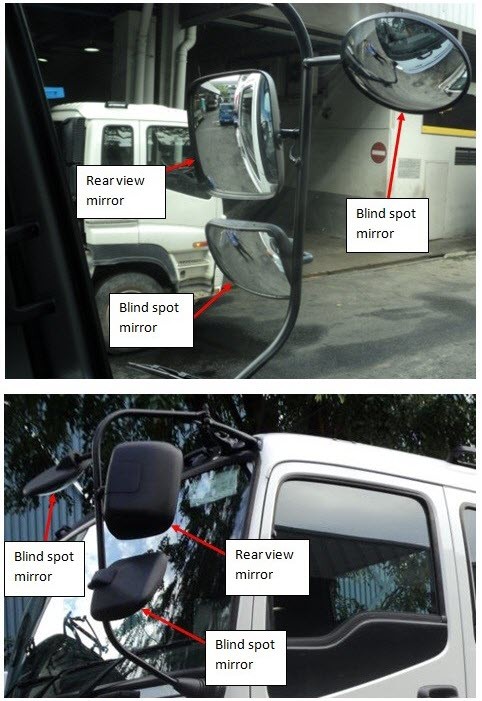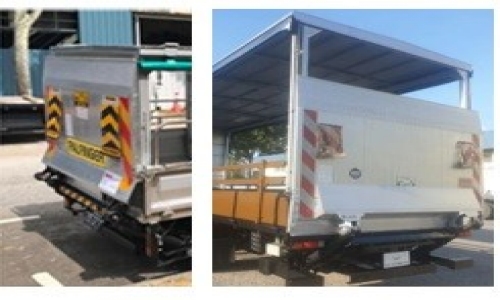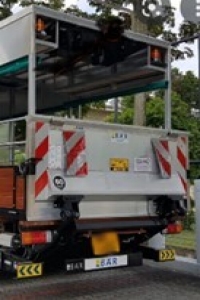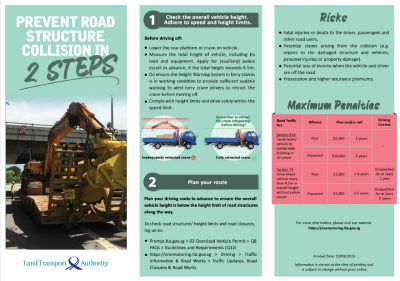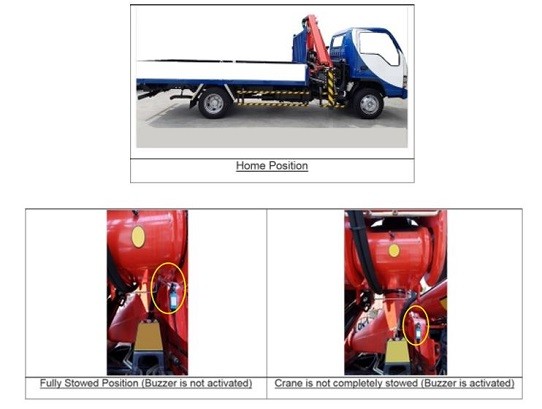Learn about the different types of commercial vehicles and the restrictions that apply to them.
At a glance
Understanding Restrictions on Commercial Vehicles |
There are different restrictions for driving commercial vehicles, which include goods and other vehicles:
For other restrictions on driving buses, click here. |
Driving Goods Vehicles |
There are certain restrictions that apply to driving different types of goods vehicles:
Learn about blind spot safety requirements for HGVs and VHGVs with maximum laden weight (MLW) over 12,000kg. |
Driving on expressways and in tunnels |
Excluded vehicles are not allowed to be driven on expressways, and some vehicles are prohibited to be driven in tunnels. |
| Driving oversized vehicles | If your vehicle exceeds the width, length or weight requirements, you must apply for an oversized vehicle movement (OVM) permit. You may also need to engage an auxiliary police escort.
|
Find out more |
Understanding Restrictions on Commercial Vehicles
There are different restrictions for driving commercial vehicles, which include goods and other vehicles:
- The restrictions on goods vehicles vary across the types of vehicles.
- The restrictions on goods vehicles on certain roads.
- Some vehicles are not allowed to be driven on expressways and in tunnels.
- Oversized vehicles need permits to be driven on roads.
For other restrictions on driving buses, click here.
Driving Goods Vehicles
There are 4 main types of goods vehicles:
1. Light Goods Vehicles (LGVs) are vehicles with maximum laden weight (MLW) of up to 3,500kg.
2. Heavy Goods Vehicles (HGVs) are vehicles with MLW from 3,501 kg to 16,000kg.
3. Very Heavy Goods Vehicles (VHGVs) are vehicles with MLW of more than 16,000kg.
4. Goods-cum-Passenger Vehicles (GPVs) are vehicles with MLW of up to 5,000kg. GPVs are meant to transport both goods and passengers.
There are certain restrictions that apply to driving some types of commercial vehicles.
Driving a Light Goods Vehicle (LGV)
There are no special restrictions for driving LGVs.
Driving a Heavy Goods Vehicle (HGV)
Heavy Goods Vehicles (HGVs) are vehicles with a maximum laden weight (MLW) from 3,501kg to 16,000kg.
Learn about the blind spot safety requirements for HGVs and VHGVs with MLW over 12,000kg.
To park a HGV with MLW over 5,000kg, you must have a valid Vehicle Parking Certificate (VPC) to park your heavy vehicle at designated parking spaces, which are located away from residential areas.
HGVs need to be parked in the designated parking space when not in use at night between 12 midnight and 6 am.
Learn more about parking your heavy vehicle
You must apply for a police escort (PDF, 1.2MB) if your vehicle’s height exceeds 4.5m. Depending on the width of the vehicle and the roads you intend to travel on, you must also apply to LTA for an oversized vehicle movement (OVM) permit to drive an oversized vehicle on the road.
Driving a Very Heavy Goods Vehicle (VHGV)
These vehicles have a maximum laden weight (MLW) of above 16,000kg.
Learn about the blind spot safety requirements for HGVs and VHGVs with MLW over 12,000kg.
You must have a valid Vehicle Parking Certificate (VPC) to park your heavy vehicle at designated parking spaces, which are located away from residential areas.
VHGVs need to be parked in the designated parking space when not in use at night between 12 midnight and 6 am.
Learn more about parking your heavy vehicle
You must apply for a police escort (PDF, 1.2MB) if your vehicle’s height exceeds 4.5 metres. Depending on the width of the vehicle and the roads you intend to travel on, you must also apply to LTA for an oversized vehicle movement (OVM) permit to drive an oversized vehicle on the road.
Blind spot safety requirements for HGVs and VHGVs with MLW over 12,000kg
To improve the safety of vehicles and other road users, HGVs and VHGVs with MLW over 12,000kg which are registered from 1 April 2015 must be equipped with mirrors or devices (e.g. Camera Monitor System (CMS)) to cover the vehicle’s blind spot areas. This is in addition to the previous requirement of having two rear view mirrors. The additional blind spot mirrors or devices will help drivers to better detect pedestrians, cyclists, motorcyclists and other motorists who are in their blind spots, reducing the risk of accidents when heavy vehicles turn at traffic junctions or change lanes. HGVs and VHGVs with MLW over 12,000kg include cement mixers, prime movers, tipper trucks, tankers and heavy lorries.
You can approach your vehicle’s authorised agent for advice on how to meet the requirements.
The blind spot mirrors or devices fitted on the heavy vehicles must meet the relevant European or Japanese standards.
European Standard (UN ECE R46)
Japanese Standard (JSR 44)
HGVs and VHGVs (registered before 1 April 2015)
For HGVs and VHGVs with MLW 12,000kg which are registered before 1 April 2015, vehicle owners can choose to either retrofit the additional blind spot mirrors or camera devices, or install a Fresnel lens (at least A4 size) on the passenger side window.

Fresnel lens (at least A4 size)
The Fresnel lens gives the driver a better view of the blind spot directly next to the passenger door.
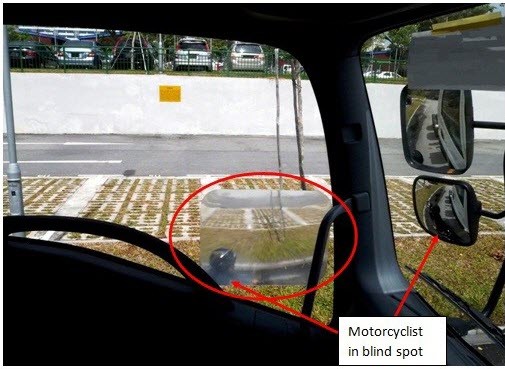
HGVs and VHGVs with MLW over 12,000kg must meet the requirements for additional blind spot mirrors or devices in order to pass their periodic inspections.
Safety regulations for lorries ferrying workers
Driving on expressways
The following vehicles are generally excluded from expressways, including expressway tunnels:
- Bicycles
- Power-assisted bicycles
- Tricycles
- Trishaws
- Motorcycles with side cars attached
- Motorcycles for which the designed maximum speed is less than 50 kilometres per hour
- Invalid carriages
- Three-wheeled vans
- Low trailers
- Road rollers
- Ready-mix concrete trucks
- Mobile cranes
- Forklifts
- Excavators
- Road pavers
- Tractors
- Dumpers
- Wheel loaders
- Bulldozers
- Graders
- Mobile concrete pumps
- Hydrant dispensers
- Motor vehicles with any of the wheels fitted with neither a pneumatic tyre nor a solid rubber tyre
- Any other motor vehicle where the maximum speed at which it may be driven on any road under the Road Traffic (Regulation of Speed) Rules (R 13) is less than 50 kilometres per hour.
You are required to apply for a permit if you need to drive an expressway-excluded vehicle on an expressway due to route constraints or where there are no alternate routes to get to your destination without the use of expressways.
You can submit the permit application via LTA's online feedback form (attention to: Vehicle Approval and Control Division):
- Application form (XLS, 33kB)
- Endorsed scanned copy of the completed application form
- Supporting documents as listed in the application form
The processing time for the application may take about 14 working days (excluding Saturdays, Sundays and Public Holidays).
Even if you are granted a permit, you are not allowed to travel on expressways during the following peak hours, unless special authorisation is granted:
- From 7.00 am to 9.30 am
- From 5.00 pm to 9.30 pm
You must comply with the approval details and conditions stated in LTA's approval letter and ensure that the approval letter is available in the vehicle for checks by LTA at all times.
Driving in tunnels
The following vehicles are not allowed to drive in all tunnels, including expressway tunnels.
- Bicycles, tricycles or trishaws
- Tankers carrying diesel fuel
- Trailers hauling standard containers
- Vehicles higher than 4.5m
- Vehicles wider than 3m
- Vehicles longer than 13m
- Vehicles transporting dangerous goods such as explosives, flammable gases or radioactive substances
In addition, these vehicles are not allowed to drive in the Sentosa Gateway Tunnel:
- All buses and goods vehicles
- Vehicles higher than 3.5m
For vehicles wider than 3m, you can apply for an oversized vehicle movement permit to drive them in tunnels.
This list is not exhaustive. For more details on vehicle restrictions in tunnels, refer to the Road Traffic (Expressway Traffic) Rules.
Entry to lorry restricted roads
This application is only for the vehicle owner or the driver of a goods vehicle entering any road with both a “Lorry Restriction” traffic sign and an “Except Authorised Vehicles” supplementary plate. An application must generally be made to the Land Transport Authority of Singapore for the goods vehicle to be authorised to enter the road. However, if there is a supplementary plate on the road that indicates a weight limit, goods vehicles that fall below this weight limit need not submit an application.
The vehicle owner or driver requesting entry is to submit details via Form.SG if
i. the vehicle cannot reach its destination by means of alternative access points or routes; and
ii. the vehicle will be used in connection with any of the following services at the destination:
a. Repair/Maintenance work services
b. Courier delivery services
c. Construction services
Please scan QR code for the application form
An application for authorisation to enter the road may be made for a period of up to 7 days. To enter the road outside this period of up to 7 days, a new application has to be made.
Goods vehicles that are used for refuse collection are authorised to enter the road and no submission of details is required.
Any information provided via the application form may be shared with the Traffic Police.
For more information/queries, please visit https://www.lta.gov.sg/feedback/ .
Driving an oversized heavy vehicle
Oversized heavy vehicles which are used to carry large and heavy cargo slow down traffic. They may also affect road structures due to their large size and heavy weight. The movement of these vehicles is therefore regulated for the safety and convenience of other road users.
You need to apply for an oversized vehicle movement (OVM) permit 3 days in advance via LTA.PROMPT for these vehicles:
- Overall width (unladen/laden) exceeds 3m (or 2.6m if you travel on controlled roads)
- Rear overhang of the load exceeds 40% of the vehicle length or 1.8m, whichever is less
- Overall weight exceeds the vehicle type's laden weight limits
In addition to applying for an OVM permit, you must engage an auxiliary police escort for these vehicles:
- Overall width (unladen/laden) exceeds 3.4m
- Overall height (unladen/laden) exceeds 4.5m
- Overall weight (unladen/laden) is 80,000kg or more
Driving an over-height vehicle
Plan your route in advance to ensure that your vehicle height does not exceed the height limit of any road structure along the way. Before moving off, if there is a crane fitted on your lorry, check that it is adequately retracted.
 Adequately Stowed Crane Position
Adequately Stowed Crane Position

Inadequately Stowed Crane Position
When driving a vehicle exceeding the height limit, follow these rules:
Plan your route and drive carefully to avoid colliding into buildings or structures. The penalties include disqualification from driving for up to 2 years, a fine up to $10,000, and imprisonment up to 5 years.
Audio warning system for lorries with cranes
From 2017, all lorries with cranes must have an audio warning system that detects whether cranes are properly stowed. This is to reduce the risk of collision with overhead road structures.
Such audio warning systems feature an audio buzzer in the driver’s cabin which is linked to a limit switch installed at the base of the crane. The buzzer is supposed to sound whenever the limit switch detects that the crane is not fully stowed.
For cranes that are unable to be fully stowed due to operational reasons, an angle sensor can be installed on the crane’s inner boom, instead of having a limit switch. When the sensor detects that the crane is above its maximum stowed height, the audio buzzer will sound to alert the driver.
New lorries with cranes must be equipped with an audio warning system before LTA will approve them for use on roads. Existing lorries with cranes must meet the requirement to pass their periodic vehicle inspections, and there may also be checks on the road.
Owner of lorries with cranes can approach their crane agent or supplier for advice on installing or retrofitting an audio warning system.
More details on the limit switch and angle sensor warning systems can be found below.







